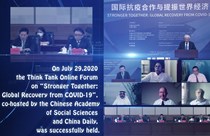Characteristics of modernizing a huge population
Author : Wang Ning Source : Chinese Social Sciences Today 2023-06-13
The report to the 20th National Congress of the CPC states that Chinese modernization is “the modernization of a huge population.” Given the enormity of its population, China must adopt a modernization model that is tailored to its unique circumstances, rather than simply replicating the Western modernization model. As President Xi Jinping noted, the Chinese path to modernization should not only observe the general principles governing modernization, but also be aligned with China’s specific realities, thereby possessing its own characteristics.
More complexity and diversity
In comparison to societies with smaller populations, China is far more complex and diverse, with greater difficulties in coordinating different regions and groups, lower risk tolerance for trial and error, and more constraints on integrated action. Western modernization, by contrast, has largely been achieved in societies with relatively smaller populations.
For instance, the UK was one of the first countries to have achieved modernization. It has a much smaller population than China and therefore fewer constraints on integrated action. The population of the US is larger but still far smaller than China’s. More importantly, most of the US population are not indigenous, but are descendants of European immigrants. American culture (as well as the culture of Canada, Australia and some other countries) can thus be regarded as the continuation, development and transformation of European culture outside of Europe, with elements of other cultures assimilated in this process.
The US began designing a top-level plan its grand system (the Constitution) soon after declaring independence. All other systems in the country embody this unitary system, which considerably reduced the cost of transitioning the country from a traditional to a modern society. In other words, the US faced far fewer obstacles from traditional culture during the modernization process. This explains why the modernization process of the US was far less complicated than that of China and other giant societies with long histories and substantial internal complexity.
Strong traditional culture and innovative governance
China’s long and rich history has given rise to a powerful traditional culture, while its vast and varied population means that macro policies can have broad implications. Even a single macro policy can elicit varying consequences and responses due to differences in customs across different regions and groups. As a result, the characteristics of China’s modernization inevitably differ from those of Western modernization.
First, China’s huge population is connected with its long history. Its people share traditional culture (both the excellent and the negative elements), giving it greater vitality and continuity. In such societies, modernization can be incredibly costly. The transformation of negative traditional culture is very slow because of the enormous amount of cultural inertia. In order to reduce the conflict between traditional culture and modernization and enhance integration, certain elements of traditional culture must be reformed in one way or another so that they are not in conflict with modernization, and may even boost it under certain conditions.
Therefore, during the modernization process, a society with a huge population will always carry with it certain aspects of traditional culture, which require proper reformation and adjustment to meet the needs of modernization. On the other hand, excellent traditional culture is able to persist precisely due to the huge population. Of course, smaller countries undergoing modernization also preserve certain cultural characteristics, but are less influenced overall by traditional culture.
Second, China’s huge population leads to multi-ethnic integration. In ancient China, orderly integration of a society with a huge and diverse population was an important task for the state. Massive resources were allocated to establish and reinforce this integration. Similarly, the modernization process also requires a unifying order that applies to all. However, on its path to modernization, China has established an innovative governance model distinct from that of ancient times.
Today, this order is achieved through the leadership of the Communist Party of China, while grassroots-level actors take the initiative and play an active role in accordance with the order. It can be said that the leadership of the CPC is the institutional soul of China’s modernization, as it stresses both top-level design and the autonomy of actors at the local and grassroots level.
Last, given its demographic reality, China has adopted an incremental model of modernization. With such a large population, top-level decision-making results in a wide scope of externalities, while decision-making at the center is subject to restrictions in many respects and involves a broad range of stakeholders. Hence China has followed an incremental path to modernization since the Reform and Opening Up. For example, small-scale pilot projects are launched first and will be widely adopted if they prove successful. As this incremental model allows for steady progress, society gradually achieves modernization through accumulation over time. Thus, incremental modernization also constitutes a feature of the modernization of a populous China.
Wang Ning is a professor in the School of Humanities at Southeast University and the School of Sociology and Anthropology at Sun Yat-sen University.
Ye Shengtao made Chinese fairy tales from a wilderness
Ye Shengtao (1894–1988) created the first collection of fairy tales in the history of Chinese children’s literature...
-
How northern ethnicities integrated into Chinese nation
2023-09-18
-
Mogao caves
2023-09-12
-
Mogao Grottoes as ‘a place of pilgrimage’
2023-09-12
-
Time-honored architectural traditions in China
2023-08-29
-
Disentangling the civilizational evolution of China
2023-08-28
-
AI ethics in science fiction
2023-08-23














 2011-2013 by www.cssn.cn. All Rights Reserved
2011-2013 by www.cssn.cn. All Rights Reserved